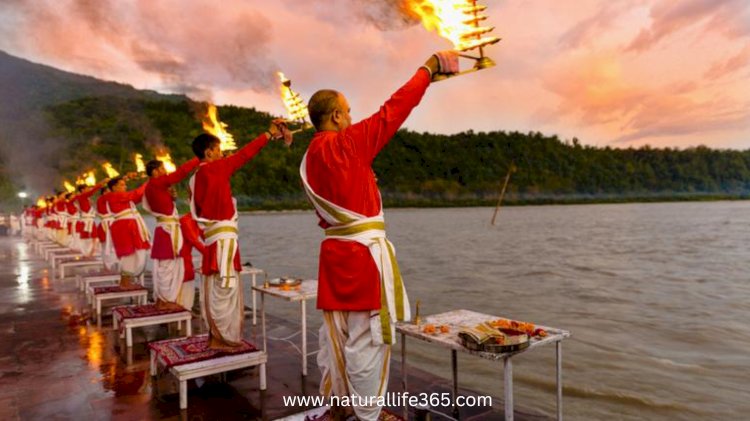Ganga Dussehra: Celebrating the Sacred River Ganges
The Ganges River is considered the most sacred river in India, and Ganga Dussehra is a celebration of its divine blessings. Join us in this blog post as we delve into the rituals and practices associated with this auspicious occasion.

Ganga Dussehra is a significant festival celebrated by Hindus across India to honor the holy river Ganges. It is observed on the 10th day (Dussehra) of the waxing moon in the Hindu month of Jyeshtha, which typically falls in May or June. In 2023, Ganga Dussehra will fall on 30th May.
The festival holds great cultural, spiritual, and environmental significance, as the River Ganges is considered one of the holiest rivers in India. It is believed that a dip in the Ganges can cleanse one's sins and provide spiritual purification. Thus, Ganga Dussehra is an important time for devotees to express their gratitude and devotion to the river.
The history of Ganga Dussehra can be traced back to ancient Hindu texts, such as the Ramayana and Mahabharata, which mention the sacred nature of the River Ganges. It is believed that the river originated from Lord Shiva's dreadlocks and flowed down to Earth to cleanse the sins of humanity.
In this blog, we will explore the significance of the River Ganges, the rituals and traditions associated with Ganga Dussehra, and the celebration of the festival in different regions of India. We will also discuss the environmental challenges facing the River Ganges and the efforts being made to preserve its sanctity. Finally, we will reflect on the importance of sustainable practices to ensure the longevity of this sacred river.
You can also read Celebrate Saraswati Puja: Discover the Significance of Vasant Panchami
The Significance of the River Ganges
The River Ganges, also known as the Ganga, is a sacred river that flows through India and Bangladesh. It is not just a river, but an embodiment of divinity, spirituality, and purity. The river has played an integral role in the lives of the people of India since ancient times and continues to hold great significance in the present day.
The history and cultural significance of the River Ganges can be traced back to the ancient Hindu texts, where it is mentioned as a divine entity. According to Hindu mythology, the River Ganges originated in the heavens and descended to Earth to purify and liberate humanity from their sins. The river is considered a goddess, Ganga Devi, and is worshipped by millions of people across India.
Apart from its spiritual significance, the River Ganges also holds great environmental importance. It is the lifeline of millions of people in India and Bangladesh, providing them with water for drinking, irrigation, and other purposes. However, the river faces several environmental challenges, including pollution, deforestation, and soil erosion, which threaten its sanctity.
Despite these challenges, the River Ganges remains an integral part of India's cultural heritage and identity. Millions of people visit the river every year to take a dip and seek blessings from the goddess Ganga Devi. The river is also home to several species of aquatic life, making it an important ecological hotspot.
Who is the Goddess Ganga?
Goddess Ganga, also known as Ganga Devi or Ganga Ma, is a prominent figure in Hindu mythology and is considered the personification of the River Ganges. According to Hindu scriptures, Ganga is one of the seven sacred rivers and is believed to have descended from the heavens to cleanse the sins of humanity.
The story of Goddess Ganga's descent is mentioned in various Hindu scriptures, including the Ramayana, Mahabharata, and Puranas. According to the legend, Ganga was the daughter of King Himavat, the personification of the Himalayan Mountains, and was known for her beauty and purity.
King Bhagiratha, an ancestor of Lord Rama, sought to bring the River Ganges to earth to cleanse the sins of his ancestors. He prayed to Lord Brahma, who advised him to seek Lord Shiva's help in bringing the River Ganges to earth.
Lord Shiva agreed to help and asked Ganga to descend to Earth. As Ganga descended, the force of the river was so strong that it threatened to wash away the earth. Lord Shiva then trapped the river in his matted locks and released it in a controlled manner, thereby bringing the River Ganges to earth.
In Hindu mythology, Goddess Ganga is revered as a symbol of purity, beauty, and grace. She is often depicted riding on a crocodile or a swan, carrying a water pot or a lotus flower in her hands. It is believed that worshipping Ganga Devi can purify one's sins and grant moksha (liberation) from the cycle of birth and death.
Goddess Ganga is worshipped in various forms across India, especially in regions along the River Ganges. The annual Ganga Dussehra festival is celebrated to honor the descent of the River Ganges and seek the blessings of Goddess Ganga.
Rituals and Traditions of Ganga Dussehra
As mentioned before, the Ganga Dussehra is a festival that celebrates the River Ganges and its divine power. The festival is observed by Hindus across India and is marked by various rituals and traditions.
Preparations for Ganga Dussehra usually begin a few days before the festival. Devotees start cleaning their homes and surroundings, and many visit the banks of the River Ganges to offer prayers and seek blessings. They also take a dip in the holy river and perform puja (worship) rituals.
On the day of Ganga Dussehra, devotees wake up early and take a bath before performing the puja rituals. They offer flowers, incense sticks, and sweets to the river and seek blessings for themselves and their loved ones. Many also perform aarti (a Hindu ritual of worship) in the evening, where lamps are lit and offered to the river.
During Ganga Dussehra, many devotees also participate in the Ganga Snan (bathing in the Ganges) ceremony. They take a dip in the river and offer prayers to the goddess Ganga Devi. It is believed that bathing in the river during Ganga Dussehra can cleanse one's sins and provide spiritual purification.
Apart from these rituals, Ganga Dussehra is also a time for cultural celebrations. Many cities across India organize cultural events, including music and dance performances, to mark the festival. In some regions, processions are carried out with the idol of Ganga Devi.
The Celebration of Ganga Dussehra in Different Regions
Ganga Dussehra is a festival that is celebrated with great fervor and enthusiasm by Hindus across India. While the festival is observed in similar ways across the country, different regions have their unique ways of celebrating the festival.
In the northern parts of India, particularly in the states of Uttar Pradesh and Bihar, Ganga Dussehra is celebrated with great zeal. The festival is marked by a grand procession, which includes the idol of Ganga Devi being carried through the streets. In Varanasi, one of the holiest cities in India, the festival is celebrated with the lighting of lamps and the performance of aarti on the banks of the River Ganges.
In the eastern state of West Bengal, Ganga Dussehra is celebrated as a part of the month-long festival of Ganga Puja. The festival is observed with the worship of the river, and devotees dip in the river to seek blessings. In Kolkata, the capital city of West Bengal, cultural programs and processions are held, and the festival is celebrated with great pomp and show.
In the western state of Maharashtra, the festival of Ganga Dussehra is celebrated as Jyeshtha Shukla Dasami. The festival is observed with the offering of prayers and flowers to the River Ganges. In some regions, the idol of Ganga Devi is worshipped and taken out in a procession.
In the southern parts of India, the festival of Ganga Dussehra is not widely celebrated because the banks of the Ganga River are not located there.
As you can see, Ganga Dussehra is a festival celebrated in different ways in different regions. It is a time for cultural celebrations and religious fervor and a time to express gratitude and devotion to the holy river.
Environmental Concerns and Preservation Efforts
The River Ganges is not just a sacred river for Hindus but also an essential source of livelihood and water supply for millions of people in India. However, the river has been facing significant environmental issues for several decades. The pollution of the river has been a significant concern for environmentalists and policymakers, and various efforts are underway to preserve the river and its ecosystem.
One of the most significant environmental concerns for the River Ganges is pollution. The river is heavily polluted with industrial waste, untreated sewage, and other harmful substances. The pollution of the river has not only affected the water quality but also the flora and fauna that depend on the river ecosystem. Several animal species that live in the river are facing extinction, and the human population that depends on the river for livelihood is at risk.
In recent years, several efforts have been made to preserve the River Ganges and its ecosystem. The Indian government has launched several initiatives, including the Namami Gange program, to clean up the river and reduce pollution. The program involves various activities such as building sewage treatment plants, cleaning up riverbanks, and creating awareness about the importance of preserving the river.
Apart from government initiatives, several non-governmental organizations (NGOs) and community-based organizations (CBOs) are also working towards preserving the River Ganges. These organizations are engaging with the local population and raising awareness about the importance of protecting the river ecosystem. They are also involved in activities such as cleaning up the riverbanks, planting trees, and reducing the use of plastic to prevent pollution.
In conclusion, the preservation of the River Ganges and its ecosystem is crucial for the millions of people who depend on the river for their livelihood and water supply. The pollution of the river is a significant environmental concern, but efforts are underway to clean up the river and reduce pollution. It is important for all stakeholders, including the government, NGOs, and local communities, to unite and work towards preserving the river for future generations. Ganga Dussehra can serve as an occasion to create awareness about environmental concerns and to pledge toward preservation efforts.
Final Thoughts and Future Outlook
In conclusion, Ganga Dussehra is a festival that celebrates the sacred river Ganges and its significance in Hindu mythology and culture. The festival is observed with great enthusiasm and devotion by Hindus across India and is marked by various rituals and traditions.
However, the celebration of Ganga Dussehra also brings to light the environmental concerns that the River Ganges is facing. The pollution of the river is a significant concern for the preservation of the river ecosystem and the millions of people who depend on the river for their livelihood and water supply.
Efforts are underway to preserve the River Ganges, and it is essential for all stakeholders to come together and work towards the preservation of the river. The government, NGOs, and local communities must collaborate to reduce pollution and protect the river ecosystem.
As we celebrate Ganga Dussehra, let us take a pledge to work towards the preservation of the River Ganges and its ecosystem. Let us raise awareness about the environmental concerns that the river is facing and make a conscious effort to reduce pollution and protect the river. By doing so, we can ensure that the River Ganges remains a source of life and inspiration for generations to come.
You can also read What is The True Meaning of Diwali?
If you value these free online resources provided by Natural Life 365, please consider supporting my website by sharing the blogs![]()






































